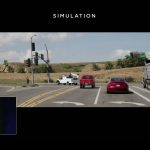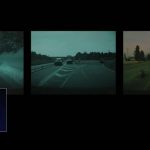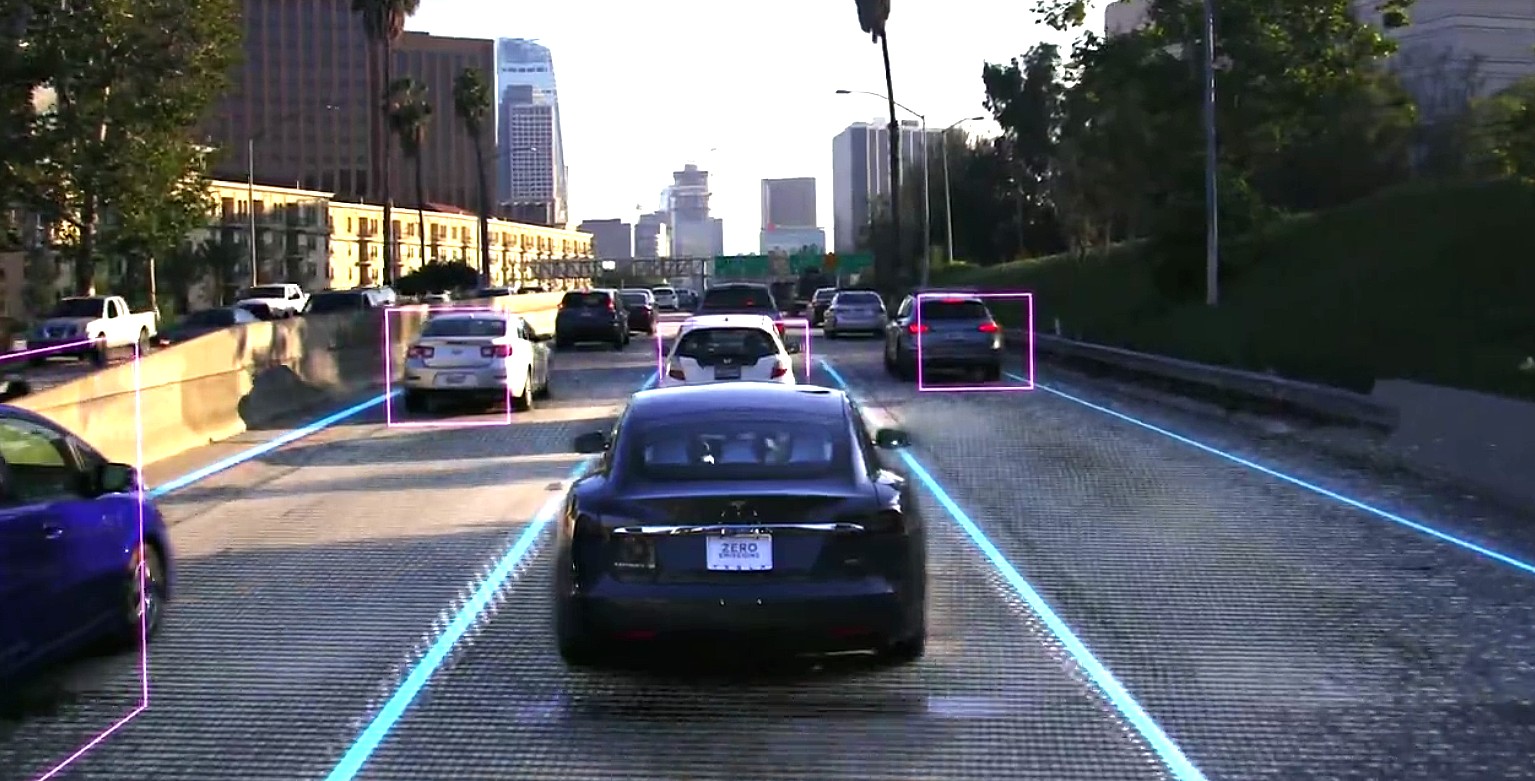
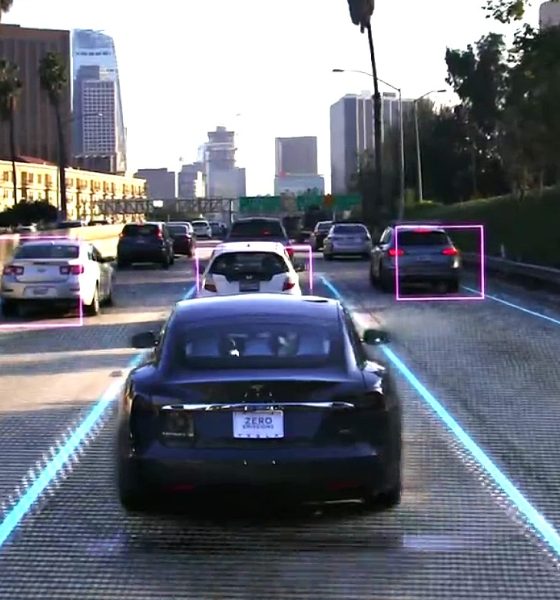
Firmware
Tesla showcases Autopilot, Full Self-Driving tech in Autonomy Day (Live Blog)
Tesla is holding its Autonomy Day today, with the company inviting investors to its headquarters in Palo Alto, CA to get a deep dive into the company’s full self-driving initiatives. During the event, Tesla will be sharing its full self-driving roadmap to attendees. Several key executives involved in the company’s autonomous driving project such as CEO Elon Musk, VP of Engineering Stuart Bowers, VP of Hardware Engineering Pete Bannon, and Sr. Director of AI Andrej Karpathy will be addressing the event’s attendees as well.
Investors will also have the opportunity to experience test rides in vehicles that are equipped with Autopilot and Full Self-Driving features that are yet to be released. With Autonomy Day, Tesla has the potential to establish itself as a key player in the autonomous vehicle race, a competition that is currently being dominated by big players such as Waymo and GM Cruise. Elon Musk’s stance on Full Self-Driving being attainable using a system that consists primarily of cameras and artificial intelligence will also be put to the test.
The following are live updates from Tesla’s Autonomy Day. Fellow Teslarati reporter Dacia Ferris and I will be updating this article in real-time, so please keep refreshing the page to view the latest updates on this story.
Dacia 14:20 PT: Aaaand that’s a wrap! So good to hear from Elon’s brain after the trip down sheep meme world of late. Thanks for following along everyone!
Simon: 14:16 PT: Thanks for joining us for today’s live blog, everyone! Till the next time, and super appreciate your continued support for Teslarati!

Dacia 14:15 PT: IMPORTANT –> Tesla will be liable if there is an accident while using the Tesla Network, per Elon.
Dacia 14:14 PT: “[Autonomy] is basically our entire expense structure,” Elon responds to a question on how much Tesla is spending on FSD development.
Dacia 14:10 PT: A human driver is like a camera on a gimbal…it can’t see everywhere at the same time. A Tesla can see all things at all times. The things it focuses on, however, start to become very human like all the time. It turns and focuses on things in a way similar to how humans operate, Elon explains.
Dacia 14:08 PT: The neural net is eating into the software base over time… A neural net is like a cruise missile…you wouldn’t use that to swat a fly, Elon responds to a question about the types of computing happening inside the FSD computer.
Dacia 14:06 PT: Low-density areas will probably have customers owning their Tesla vehicles, only occasionally renting them vs. higher density areas with higher rates of rental, Elon predicts how customers will use the Tesla Network.
Dacia 14:05 PT: “If you have a massive amount of data saying that autonomy is safe…they’ll listen to it. They may take a long time to digest…but they’ll come to the right conclusion,” Elon comments on the regulatory process for FSD.
Dacia 14:03 PT: Tesla pickup truck mentioned!! Nothing dropped, though. Elon just says it will be revealed later this year.
Dacia 14:02 PT: “It’s financially insane to buy anything other than a Tesla [today]…it’s like buying a horse,” Elon says confidently. He’s very certain about this, given the tech advances and advantages Tesla’s vehicles have.

Dacia 13:59 PT: “We’re going to bias our sales strategy towards the smaller battery packs,” Elon says, the point being to have a higher volume of cars for the Tesla Network.
RELATED: Learn more about Tesla’s “Robotaxi” self-driving rideshare service
Dacia 13:58 PT: False and foolish = HD maps and LiDAR – the final word from Musk on two no-go’s for FSD cars. Mark his words.
Dacia 13:52 PT: Elon Musk thinks a rental car fleet instead of using the Tesla Network would be unweildy. “Try it,” he challenges an investor challenging him on that notion.
Dacia 13:50 PT: Any robo taxi that isn’t electric will not be competitive, Elon predicts. He also said that the cars will not need human supervision at all eventually, plugging themselves in, etc.
Dacia 13:49 PT: Robo taxis will be in extremely high demand for a very long time. The auto industry is very slow to adapt…there are new cars on the road right now that are still not as good as the original Model S, Elon expresses his confidence in the Tesla Network’s financial success.
Dacia 13:45 PT: Both Model S and Model 3 cars will used as robo taxis, Elon confirms. THIS IS BIG: The current battery pack is good for about 300-500,000 miles. The new battery pack that will probably go into production for next year will operate for **1 million miles** with minimal maintenance, he announces, specifying that the improvements are driven by the Tesla Network development. As parts become less and less important (steering wheels, pedals, etc.), they will delete them from the cars.
Dacia 13:39 PT: “You’ll be able to add or subtract your car to the fleet from your phone,” Elon says, teasing how the Robotaxi Tesla Network will operate.” You could have your car operate 1/3 of the week or longer…The fundamental utility of your vehicle will increase by a factor of 5.”
Dacia 13:37 PT: “The whole thing was designed to be a Robotaxi since October 2016,” Elon says referring to the FSD intentions for Tesla. “We said we’re gonna do the Robotaxi, and we’re gonna do the robo taxi…it just might not be on time, he jokes, referring to Elon Standard Time. Today he definitely seems determined to express his…determination.
Simon 13:36 PT: Elon Musk reiterates the Tesla Master Plan. He also jokingly notes that while he’s usually late, he and the Tesla team gets things done. Musk then notes that the Robotaxi service (Tesla Network) will likely be rolled out on 2020.

Dacia 13:30 PT: Nine million successful lane changes have been logged in Tesla cars, per Bowers. They are now seeing 100,000 automated lane changes per day. That’s a lot for the NN to learn from! No simulator necessary.
Simon 13:29 PT: Stuart describes the development cycle of Tesla’s Full Self-Driving computer, and how it blends in perfectly with the company’s neural networks.
Simon 13:21 PT: Stuart Bowers takes the stage. Notes that Navigate on Autopilot has already accumulated 70 million miles so far.
Simon 13:19 PT: Elon notes that in terms of regulators, platooning for trucks could get approval first. This sounds a lot like the Tesla Semi’s Convoy Mode, which allows the vehicles to draft semi-autonomously with each other. Perhaps the Semi will enter the market with Convoy Mode ready to use?
Dacia 13:18 PT: We expect to have FSD ready by second quarter of next year for no-hands on steering wheel, no looking out the window use, Elon predicts regarding the Autopilot timeline. FSD will be “feature complete” this year.
Dacia 13:13 PT: Elon on GPS: We don’t want to use GPS as primary navigation. It’s fine for tips and tricks, places you know and drive in confidently…counterintuitive shortcuts. But the GPS overlay data should only be helpful but never primary. If it’s ever primary, that’s a problem.
Dacia 13:11 PT: We have 425,000 cars with this hardware…providing data…that’s a massive compression of real world data, Elon touts. “I suppose there could be another use for the hardware,” Elon speculates. “Maybe some sort of AWS angle.” He’s referring to Amazon’s cloud computing, or something similar, perhaps.
Dacia 13:07 PT: “You only need radar in the forward direction because you’re going really fast,” Elon concludes.
Dacia 13:06 PT: “LiDAR is lame,” Elon replies to a comment about his ‘slam’ on the tech during the presentation. The man is clear about his feelings. “We’re gonna dump LiDAR, mark my words. That’s my prediction.” He then talks about SpaceX’s use of their own LiDAR because it makes sense. LiDAR in cars is “stupid”, he says…in case you were wondering how he **really** feels.
Simon 13:00 PT: Elon lightly mentions a mode beyond Mad Max once more. Looks like an “LA Traffic Mode” might really be released in the future.
Dacia 12:56 PT: If I were to summarize my entire talk in one slide it would be this, Andrej concludes. And that includes incidents of flying cars (the rightmost image).

Dacia 12:51 PT: After only 6 seconds of NN analysis, the 3D reproduction of the scene recorded is amazing. Depth perception is just..wow. LiDAR is used to annotate what vision is seeing.

Dacia 12:49 PT: You all used your own neural network in your brains to get here…you didn’t shoot lasers from your eyes to drive, Andrej says, explaining why NN is better for FSD than LiDAR.
Dacia 12:47 PT: “We’re gonna turn on Augmented Vision…it’s kind of scary, actually,” Elon tells the audience, referring to the test drives to come after the presentation.

Dacia 12:45 PT: “Everyone is training the network all the time, is what it comes down to,” Elon recaps the explanation of how the NN gets its data and how that data is used.
Dacia 12:44 PT: We ask the fleet to send us data focused on a problem to be solved, and that’s used to train the neural network further, Andrej explains. He previously mentioned “tunnel” problems as an example, here is using cut ins from cars coming from other lanes. The false positives and false negatives are then analyzed, used for retraining.
Simon 12:42 PT: Andrej describes how Tesla trains its Neural Network through vehicles in Shadow Mode. Based on the AI Director’s presentation, the improvements in Tesla’s capability to predict cut-ins on the road were the result of fleet learning.
Dacia 12:38 PT: “Using simulators, it’s like grading your own homework,” Elon doubles down against using simulators vs. real world driving. “It would be a monumental achievement of human capability,” he says, referring to creating a simulation that actually modeled reality.
Dacia 12:37 PT: On simulations, Tesla uses them extensively, including for training data. But there really is no substitute for real data. The modeling isn’t the same…the real world throws some crazy stuff at you. Snow, trees, construction sites, plastic bags flying in the wind, etc., all interact differently and give different data, Andrej continues teaching the investor audience how NN’s work.
Simon 12:32 PT – Neural Networks like data. Lots of it. More data just makes them work better. There really is no substitute for physical data. Andrej shows a comparison of its simulation vs its real-world road data.
Dacia 12:30 PT: Neural network training seems a lot like mathematical opinion making.
Simon 12:30 PT: Andrej describes the work being done by Tesla to train its neural networks. The amount of detail in terms of labeling data is insane.
Dacia 12:28 PT: “It really is the Matrix,” Elon comments as Andrej explains how computers “see” things and learn from them.
Simon 12:27 PT: Andrej Karpathy takes the stage. A video of Tesla Vision is shown on stage. Particularly interesting is how high-definition the video in the sample was. Andrej proceeds to explain how neural networks are similar to the human brain.

Dacia 12:26 PT: Andrej Karpathy, Sr. Director of AI at Tesla, his team is resposible for training the neural networks. Elon thinks he may be the best “computer vision guy” in the world. (Elon’s IQ would probably know these things.)
Dacia 12:32 PT: People effectively program Google with their queries… We have quite a good simulation, but it doesn’t fully capture the real world. If it did, it would be proof that WE were living in a simulation, Elon responds to critique about real world miles needed for FSD.
Simon 12:22 PT: Elon on simulated miles. “Simulations don’t capture the real world,” Elon said.
Dacia 12:21 PT: That’s a hard problem. Anyone who can solve (hack) it, I’d hire in a second, Elon emphasis the difficulty in completely encrypting Tesla’s chip software. It’s already a “hard chip to crack.” PWN2OWN – the 3 year live stream?
Dacia 12:17 PT: The neural processor design is custom by Tesla, not external IP, Bannon confirms for an investor. *** Fabricating is being done by Samsung in Austin, TX. ***
Dacia 12:16 PT: The next generation chip will be about 3X better than the current one…about 2 years away, Elon answers a question regarding what’s next for FSD computer, after saying he doesn’t want to talk much about it. The man is always looking forward to the next milestone, as impossible as it seems.
Dacia 12:14 PT: Power consumption for FSD is 250 watts per mile, per Elon. It also depends on the type of driving, per Elon.
Simon 12:13 PT: Elon Musk speaks his mind about the use of LiDAR for full self-driving once more. “LiDAR is a fool’s errand, and anyone who relies on LiDAR is doomed. It’s like having expensive appendices. You’ll see,” he said.
Dacia 12:10 PT: (over Nvidia) Elon mentions “Xavier” power requirements are higher and power requirement is 7x and costs 7x. You can do neural networks that are 7X more powerful on Tesla’s chip vs. NVIDIA’s, Bannon explains to an investor in the audience.
Dacia 12:07 PT: “It seems improbable. How could it be that Tesla, who has never designed a chip before, would design the best chip in the world? But that is objectively what has occurred,” Elon touts.”All Tesla’s being produced right now have this chip,” he doubles down. “All Tesla cars right now have everything necessary for FSD. All you have to do is update the software.”
Simon 12:08 PT: A wild next-generation Tesla Roadster has appeared.

Simon 12:05 PT: Elon Musk notes that Tesla switched over to switched over Model S and X about a month ago, Model 3 about 10 days ago. Every car today has this hardware installed.
Teslarati Audience 12:00 PT: “Like i am 100% sure all the finance guys in the audience understand like less than 1% of this… I study CS and i understand maybe 2-5% of this…” @meamZ_MZ
Simon 12:02 PT: Pete Bannon’s in-depth presentation of Hardware 3 and Tesla’s custom solutions shows just how much of a tech company Tesla really is. I’ve yet to see a carmaker present anything similar to date.
Dacia 12:01 PT: You need 1 TB per second of bandwith per engine to operate FSD, 2 on the chip, Bannon continues. Again highlighting how amazing this computer is.
Dacia 11:56 PT: FSD only operates software that’s cryptographically signed by Tesla – it will NOT operate software that isn’t Tesla’s, Bannon says. Wow. I wonder if that will be part of a PWN2OWN or Bug Bounty program?
Dacia 11:55 PT: 50 trillion operations per second was the goal performance for HW3, 72 trillion operations per second achieved. Amazing. Makes me think of SpaceX’s engines always overachieving the performance goals.
Dacia 11:53 PT: The size of the CPU is in the “sweet spot” between cell phone CPU size and high-end CPU size, Bannon says as a picture of HW3’s processor is on screen.
Tesla’s neural network processor. (Credit: Tesla)
Dacia 11:52 PT: “The general principal of this is that any part of this could fail and the car keeps driving,” Elon clarifies the importance of the redundancy built into the FSD computer. A picture of the full computer is on the screen – it fits in the top part of the glove box. So small, so powerful.
Dacia 11:45 PT: “Hopefully you’ll all still be awake by then,” Pete Bannon, system architect for FSD, jokes prior to beginning his presentation. I should have grabbed coffee. Three years from start of FSD group to deployment of HW3 in all 3 Tesla cars – that’s amazing.

Simon 11:43 PT: Elon Musk has taken the stage and gives the floor to Pete Bannon. Pete describes the timeline of Tesla’s Full Self-Driving chip. Retrofitting employee cars started December. “It’s the fastest systems development program I have ever seen,” Bannon said.
Simon 11:35 PT: During the third quarter earnings call, Andrej mentioned something about a large Neural Network that Tesla had already trained, but was not able to deploy due to computational constraints. Personally excited to see this neural net in action when paired with Hardware 3.
Simon 11:32 PT: So just to review, we’re expecting to see a number of pertinent updates on Tesla’s Full Self-Driving initiatives today. Personally looking forward to Stuart Bowers, Pete Bannon, and Andrej Karpathy’s segments in the event.
Simon 11:32 PT: This song will effectively be stuck in my head for the rest of the day. I guarantee it.
Dacia 11:31 PT: “New Rule” for live stream events in future: More than one soundtrack for film reel.
Dacia 11:30 PT: Okay, half hour late now. Well…it did say Autonomy “Day”.
Dacia 11:26 PT: I love that the Tesla Semi is in this video roll. Would be even MORE awesome if the Semi was part of the Autopilot demo.
Simon 11:24 PT: We’re approaching 25 mins late. Looks like Autonomy Day will start in Elon Time. Not sure if that’s a good sign or a bad sign.
Dacia 11:14 PT: Seeing complaints on Twitter about the video, now. Some are amusing, some not so much.
Simon 11:10 PT: We’re at 13 mins late now. But the new footage sure is sweet. The Roadster shots are particularly amazing.
Dacia 11:10 PT: Well, the livestream is late…but this video footage is amazing. We haven’t seen most of these shots before. There are some Autopilot features intertwined – nice touch!

Firmware
Tesla mobile app shows signs of upcoming FSD subscriptions
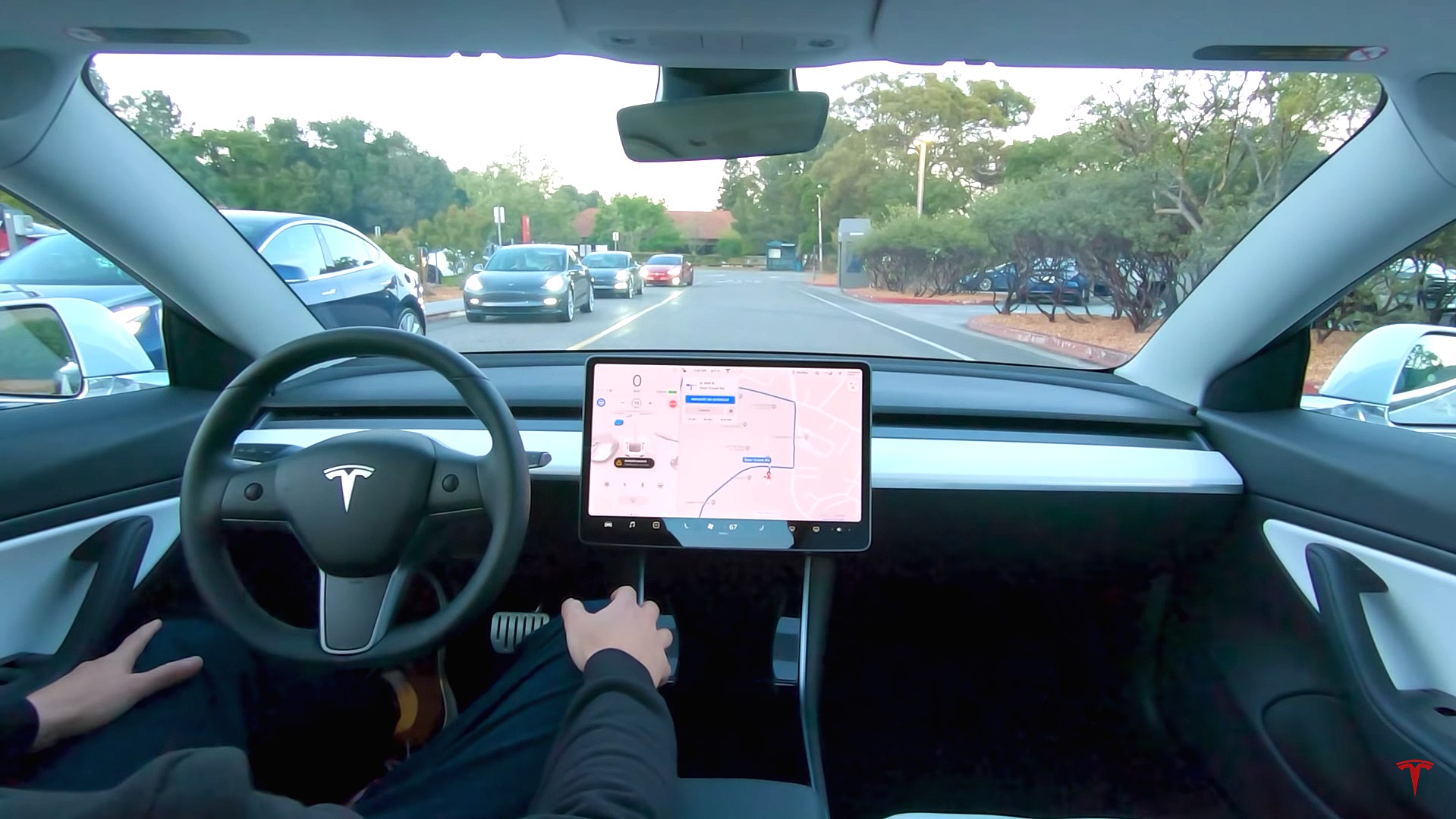
It appears that Tesla may be preparing to roll out some subscription-based services soon. Based on the observations of a Wales-based Model 3 owner who performed some reverse-engineering on the Tesla mobile app, it seems that the electric car maker has added a new “Subscribe” option beside the “Buy” option within the “Upgrades” tab, at least behind the scenes.
A screenshot of the new option was posted in the r/TeslaMotors subreddit, and while the Tesla owner in question, u/Callump01, admitted that the screenshot looks like something that could be easily fabricated, he did submit proof of his reverse-engineering to the community’s moderators. The moderators of the r/TeslaMotors subreddit confirmed the legitimacy of the Model 3 owner’s work, further suggesting that subscription options may indeed be coming to Tesla owners soon.
Did some reverse engineering on the app and Tesla looks to be preparing for subscriptions? from r/teslamotors
Tesla’s Full Self-Driving suite has been heavily speculated to be offered as a subscription option, similar to the company’s Premium Connectivity feature. And back in April, noted Tesla hacker @greentheonly stated that the company’s vehicles already had the source codes for a pay-as-you-go subscription model. The Tesla hacker suggested then that Tesla would likely release such a feature by the end of the year — something that Elon Musk also suggested in the first-quarter earnings call. “I think we will offer Full Self-Driving as a subscription service, but it will be probably towards the end of this year,” Musk stated.
While the signs for an upcoming FSD subscription option seem to be getting more and more prominent as the year approaches its final quarter, the details for such a feature are still quite slim. Pricing for FSD subscriptions, for example, have not been teased by Elon Musk yet, though he has stated on Twitter that purchasing the suite upfront would be more worth it in the long term. References to the feature in the vehicles’ source code, and now in the Tesla mobile app, also listed no references to pricing.
The idea of FSD subscriptions could prove quite popular among electric car owners, especially since it would allow budget-conscious customers to make the most out of the company’s driver-assist and self-driving systems without committing to the features’ full price. The current price of the Full Self-Driving suite is no joke, after all, being listed at $8,000 on top of a vehicle’s cost. By offering subscriptions to features like Navigate on Autopilot with automatic lane changes, owners could gain access to advanced functions only as they are needed.
Elon Musk, for his part, has explained that ultimately, he still believes that purchasing the Full Self-Driving suite outright provides the most value to customers, as it is an investment that would pay off in the future. “I should say, it will still make sense to buy FSD as an option as in our view, buying FSD is an investment in the future. And we are confident that it is an investment that will pay off to the consumer – to the benefit of the consumer.” Musk said.
Firmware
Tesla rolls out speed limit sign recognition and green traffic light alert in new update
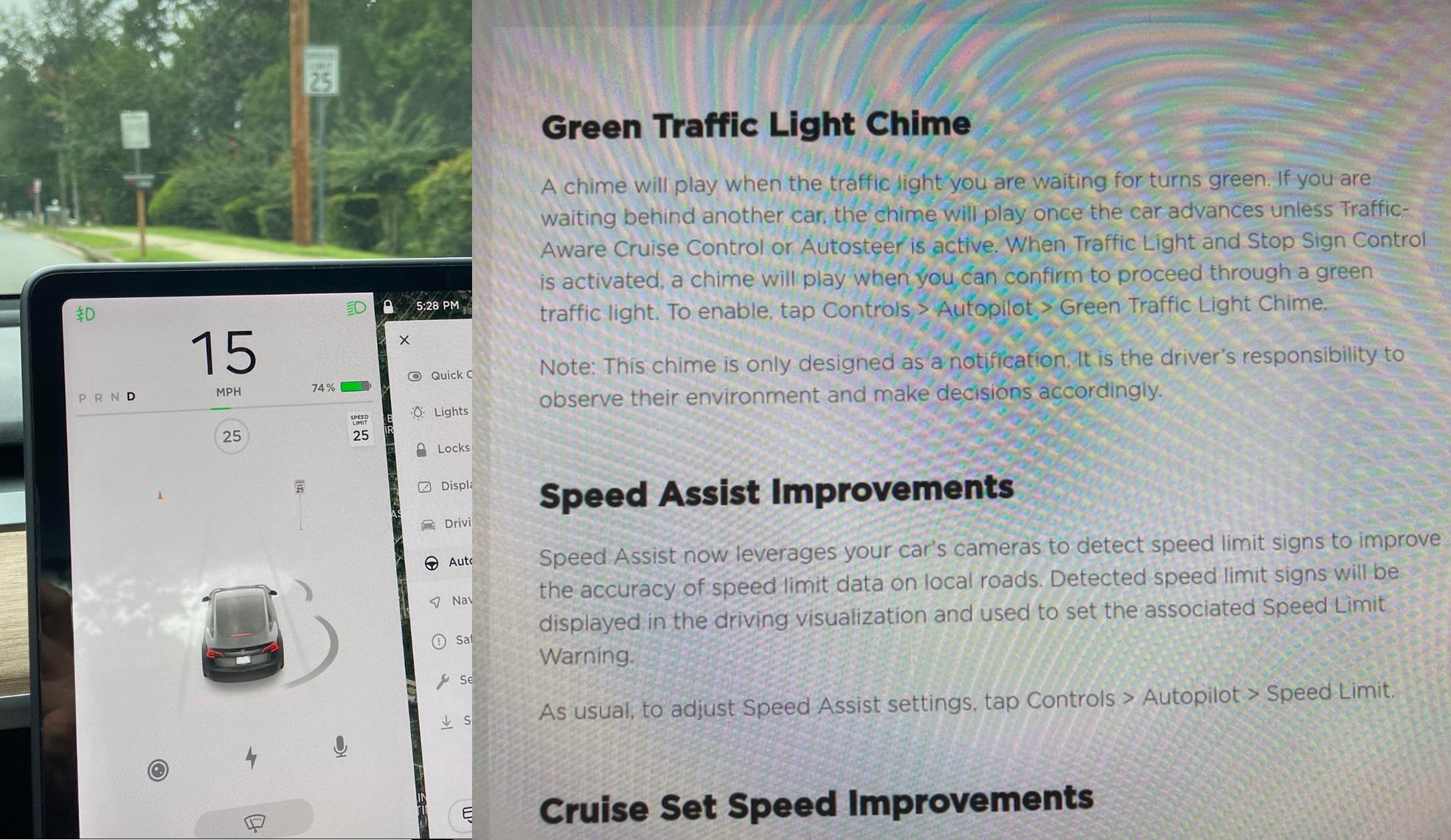
Tesla has started rolling out update 2020.36 this weekend, introducing a couple of notable new features for its vehicles. While there are only a few handful of vehicles that have reportedly received the update so far, 2020.36 makes it evident that the electric car maker has made some strides in its efforts to refine its driver-assist systems for inner-city driving.
Tesla is currently hard at work developing key features for its Full Self-Driving suite, which should allow vehicles to navigate through inner-city streets without driver input. Tesla’s FSD suite is still a work in progress, though the company has released the initial iterations of key features such Traffic Light and Stop Sign Control, which was introduced last April. Similar to the first release of Navigate on Autopilot, however, the capabilities of Traffic Light and Stop Sign Control were pretty basic during their initial rollout.
2020.36 Showing Speed Limit Signs in Visualization from r/teslamotors
With the release of update 2020.36, Tesla has rolled out some improvements that should allow its vehicles to handle traffic lights better. What’s more, the update also includes a particularly useful feature that enables better recognition of speed limit signs, which should make Autopilot’s speed adjustments better during use. Following are the Release Notes for these two new features.
Green Traffic Light Chime
“A chime will play when the traffic light you are waiting for turns green. If you are waiting behind another car, the chime will play once the car advances unless Traffic-Aware Cruise Control or Autosteer is active. When Traffic Light and Stop Sign Control is activated, a chime will play when you can confirm to proceed through a green traffic light. To enable, tap Controls > Autopilot > Green Traffic Light Chime.
“Note: This chime is only designed as a notification. It is the driver’s responsibility to observe their environment and make decisions accordingly.”
Speed Assist Improvements
“Speed Assist now leverages your car’s cameras to detect speed limit signs to improve the accuracy of speed limit data on local roads. Detected speed limit signs will be displayed in the driving visualization and used to set the associated Speed Limit Warning.
“As usual, to adjust Speed Assist settings, tap Controls > Autopilot > Speed Limit.”
Footage of the new green light chime in action via @NASA8500 on Twitter ✈️ from r/teslamotors
Amidst the rollout of 2020.36’s new features, speculations were abounding among Tesla community members that this update may include the first pieces of the company’s highly-anticipated Autopilot rewrite. Inasmuch as the idea is exciting, however, Tesla CEO Elon Musk has stated that this was not the case. While responding to a Tesla owner who asked if the Autopilot rewrite is in “shadow mode” in 2020.36, Musk responded “Not yet.”
Firmware
Tesla rolls out Sirius XM free three-month subscription
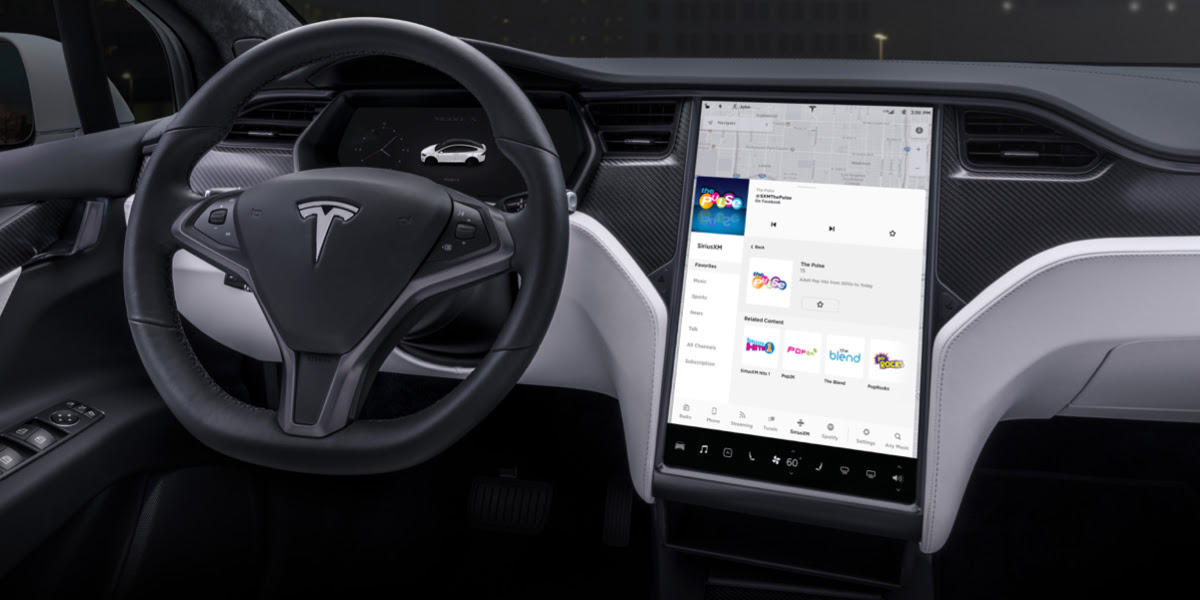
Tesla has rolled out a free three-month trial subscription to Sirius XM, in what appears to be the company’s latest push into making its vehicles’ entertainment systems more feature-rich. The new Sirius XM offer will likely be appreciated by owners of the company’s vehicles, especially considering that the service is among the most popular satellite radios in the country today.
Tesla announced its new offer in an email sent on Monday. An image that accompanied the communication also teased Tesla’s updated and optimized Sirius XM UI for its vehicles. Following is the email’s text.
“Beginning now, enjoy a free, All Access three-month trial subscription to Sirius XM, plus a completely new look and improved functionality. Our latest over-the-air software update includes significant improvements to overall Sirius XM navigation, organization, and search features, including access to more than 150 satellite channels.
“To access simply tap the Sirius XM app from the ‘Music’ section of your in-car center touchscreen—or enjoy your subscription online, on your phone, or at home on connected devices. If you can’t hear SiriusXM channels in your car, select the Sirius XM ‘Subscription’ tab for instruction on how to refresh your audio.”
Tesla has actually been working on Sirius XM improvements for some time now. Back in June, for example, Tesla rolled out its 2020.24.6.4 update, and it included some optimizations to its Model S and Model X’s Sirius XM interface. As noted by noted Tesla owner and hacker @greentheonly, the source code of this update revealed that the Sirius XM optimizations were also intended to be released to other areas such as Canada.
Interestingly enough, Sirius XM is a popular feature that has been exclusive to the Model S and X. Tesla’s most popular vehicle to date, the Model 3, is yet to receive the feature. One could only hope that Sirius XM integration to the Model 3 may eventually be included in the future. Such an update would most definitely be appreciated by the EV community, especially since some Model 3 owners have resorted to using their smartphones or third-party solutions to gain access to the satellite radio service.
The fact that Tesla seems to be pushing Sirius XM rather assertively to its customers seems to suggest that the company may be poised to roll out more entertainment-based apps in the coming months. Apps such as Sirius XM, Spotify, Netflix, and YouTube, may seem quite minor when compared to key functions like Autopilot, after all, but they do help round out the ownership experience of Tesla owners. In a way, Sirius XM does make sense for Tesla’s next-generation of vehicles, especially the Cybertruck and the Semi, both of which would likely be driven in areas that lack LTE connectivity.
